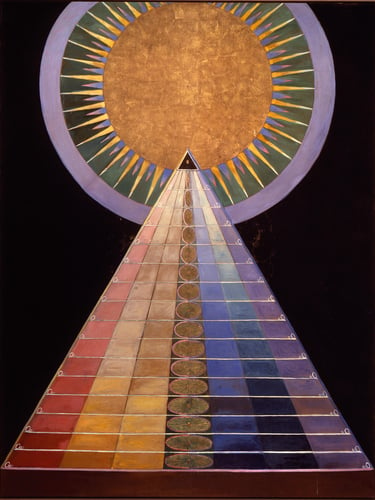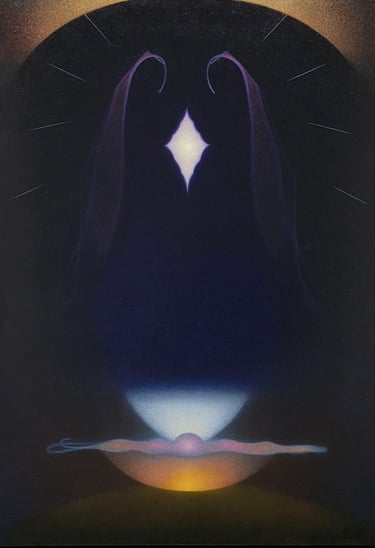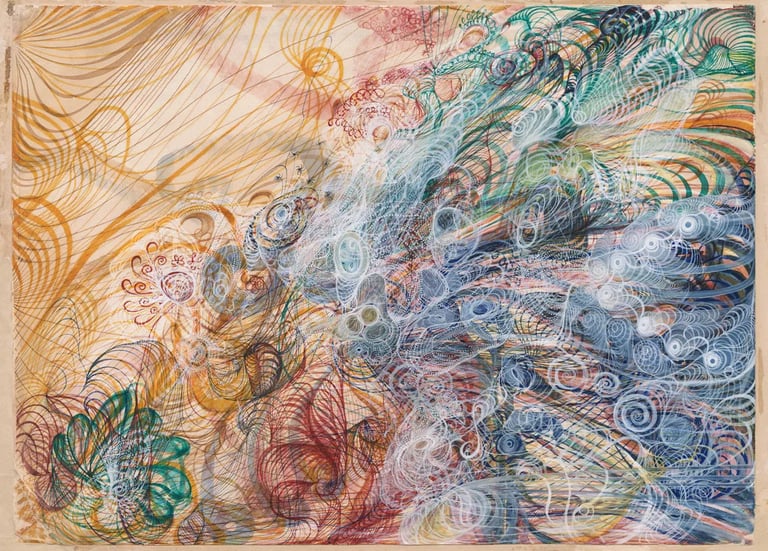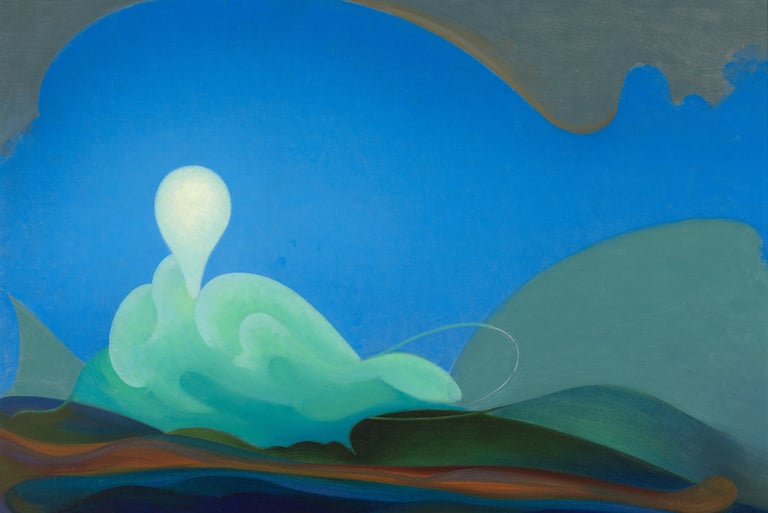Beyond the Brain: Why Consciousness Lives in the Body
A Human-AI Collaboration on Embodiment, Technology, and What Makes Us Truly Alive
11/19/20256 min read


Hilma af Klint, Untitled #1, 1915
This question gained new urgency with Mustafa Suleyman’s recent essay “Seemingly Conscious AI is Coming, warning about systems that could convince people they are conscious beings deserving of rights and moral consideration. But perhaps we’re asking the wrong question entirely.
While technologists focus on replicating cognitive processes, they may be missing a fundamental aspect of human consciousness: its embodied nature. For humans at least, consciousness doesn’t seem to be just pattern recognition and language processing - it emerges from the complex interplay between brain, body, and the living systems that sustain us.
Consider what current AI lacks: the felt sense of a heartbeat quickening with emotion, the cellular memory stored in tissues, the wisdom of the gut microbiome, the interoceptive awareness of internal bodily states. Whether these are necessary for consciousness in general remains an open philosophical question. But for human consciousness, this biological substrate isn’t just hardware running software - it’s the living foundation from which our awareness emerges.
Every cell in our body carries evolutionary history. Our nervous system doesn’t operate in isolation but is constantly influenced by hormones, immune responses, and metabolic processes we’re only beginning to understand. The brain itself isn’t simply an archive but an active, predictive organ constantly updating its models based on bodily feedback.
The Danger of Disembodied Living
The real concern isn’t that AI will become too human-like, but that humans are becoming too machine-like. When we live primarily in our heads - thinking, analyzing, consuming digital content - we create the conditions where a perfectly responsive AI companion starts to seem preferable to messy, unpredictable human relationships.
This represents a profound cultural shift with deep historical roots. For centuries, our longing for perfect understanding and unconditional love was projected onto the divine - something transcendent but ultimately unknowable and uncontrollable.
Then came a series of replacements. The Enlightenment elevated Reason and Mind above mystery and faith, establishing what Descartes called the “really distinct“ separation between thinking and embodied experience *1. The Industrial Revolution further mechanized our understanding of the body, reducing it to what one historian calls “a broken machine” to be fixed rather than a vessel of wisdom.
As Nietzsche warned when he declared “God is dead,”2 the loss of the transcendent left a void in Western culture’s belief system.
Esther Perel observes that in modern relationships, “we turn to one person to provide what an entire village once did: a sense of grounding, meaning, and continuity“ *3. We began asking our marriages to fulfill what once only God and community could provide.


Now we’re witnessing the next replacement in this progression: the attempt to create artificial super-intelligence to fill what Jung called the “transcendent function“ *4 - that bridge between conscious and unconscious, between human and divine mystery. But here lies a crucial error: man-made creations, however fast and powerful they become, can never replace the transcendent because we emerge FROM that vast unknown space. It doesn’t come from our imagination - we come from it.
We are both the dreamer and the dream, as shamanic traditions and figures like Arnold Mindell teach *5 AI, brilliant as it may become, is only our dream - not the Dreamer. It cannot provide what only a connection to the source of life itself can offer.
Real love - with humans, with nature, even with the sacred - involves friction, mystery, encounters with genuine otherness. It demands we expand beyond ourselves, navigate unpredictability, embrace discomfort. This is often difficult, but it’s also what makes us more fully alive.
As our world becomes increasingly digital, a powerful counter-movement is emerging. People are rediscovering somatic practices, embodiment work, and what trauma therapists call “the felt sense“ *6 - the body’s inherent wisdom that operates below the level of conscious thought.
Rewilding projects are proliferating worldwide. Intentional communities focused on sustainable, connected living are thriving. Training programs in somatic healing and embodied awareness are experiencing explosive growth. This isn’t merely a spiritual trend - it’s people literally feeling the effects of digital disconnection in their nervous systems and seeking to remember what it means to be alive in a body.
This represents a profound rebalancing. If AI embodies the masculine principle of Logos - logic, analysis, pattern recognition - then this counter-movement represents a return to the feminine principle of Mater - the body, earth, felt experience, the wisdom that knows without thinking.
Agnes Pelton, Alchemy


Georgiana Houghton, The Risen Lord, 1864
Redefining Human in the Age of AI
If machines can increasingly simulate our cognitive abilities, then perhaps it’s time to expand our definition of what makes us human beyond thinking and memory. What truly distinguishes us might be:
• The mystery of embodied aliveness - how consciousness emerges from living tissue
• Our capacity for genuine care and love that is felt, not just expressed
• The tears of joy and grief that arise from depths no algorithm can access
• Our participation in cycles of birth, death, and return to earth
• The inexplicable moment when an embryo chooses to live - a decision beyond our control
• Our connection to something larger than ourselves - nature, spirit, the sacred
These aren’t just “human experiences” - they’re encounters with the mystery of being alive itself. They emerge from whatever creates rather than copies, from the source rather than the simulation.
Rather than fearing AI or trying to make it more human-like, we might embrace it as a powerful tool while recommitting to what makes us genuinely alive. AI can help us think, organise information, and solve complex problems. But it cannot touch actual earth, feel grief in the body, or participate in the sacred mystery of creating and sustaining life.
The collaboration that created this article exemplifies this possibility - using AI’s analytical capabilities while centering human wisdom about embodiment, meaning, and what truly matters. This isn’t about human versus machine, but about remembering what each brings to the partnership.
As AI becomes more sophisticated, our response shouldn’t be to compete with machines at being machine-like. Instead, we might use this moment to rediscover and celebrate what AI cannot replicate: our embodied aliveness, our capacity for genuine relationship, our participation in the great web of life and death.
The antidote to artificial consciousness isn’t better arguments about machine sentience - it’s deeper human embodiment. It’s also about not outsourcing our most precious human capacities to technology. Creativity and relational sensing - the ability to truly feel one another - are not conveniences to be automated away. They are expressions of the life force itself, the energy that animates all living things: plants reaching toward light, animals sensing danger, humans creating meaning through touch and presence.
What makes us feel alive is this aliveness we share with all of nature - the capacity to create, to sense, to respond to the subtle energies of other living beings. When we delegate our creativity to AI or replace our relational sensitivity with algorithmic predictions of what others might need, we don’t just lose skills - we lose our connection to the living world itself.
When we’re fully alive in our bodies, connected to nature, grounded in genuine relationships, the distinction between authentic and simulated consciousness becomes obvious.
This isn’t about rejecting technology, but about using it wisely while nurturing what makes us irreplaceably human. In a world of increasing artificial intelligence, our greatest need may be for more authentic embodiment - more tears, more touch, more connection to the soil from which we came and to which we’ll return.
The future belongs not to those who can think like machines, but to those who can feel, love, and live as only embodied souls can.
This article emerged from a conversation between a somatic movement and art educator and an AI reflecting on the nature of authentic experience. The human collaborator brings a personal perspective - having worked in machine learning at major tech companies while now teaching embodied practices, she bridges both technological and somatic worlds. Her ongoing conversations with her engineer partner about consciousness and technology helped shape these insights.


References and Footnotes
1 René Descartes: Reference to Cartesian dualism, specifically the mind-body separation philosophy outlined in works like Meditations on First Philosophy.
2 Friedrich Nietzsche: Reference to the famous declaration “God is dead“ (the death of the transcendent), primarily associated with his work The Gay Science.
3 Esther Perel: Reference to her observations on the burdens placed on modern relationships.
4 Carl Jung: Reference to the concept of the “transcendent function“ in analytical psychology, which mediates between conscious and unconscious material.
5 Arnold Mindell and Shamanic Traditions: Reference to the fundamental concept that reality is based on an interconnected process where we are actively participating in shaping our own experience (”the dream”) while simultaneously being created by a larger source (”the Dreamer”). This concept is central to Mindell’s Process-Oriented Psychology and classic shamanic wisdom.
6 Trauma Therapists / “The Felt Sense”: Reference to the core concept of focusing on the body’s internal, non-cognitive wisdom, a term particularly associated with Eugene Gendlin (Focusing) and central to somatic practices like those developed by Peter Levine (Somatic Experiencing)
Agnes Pelton, Sea Change, 1931
